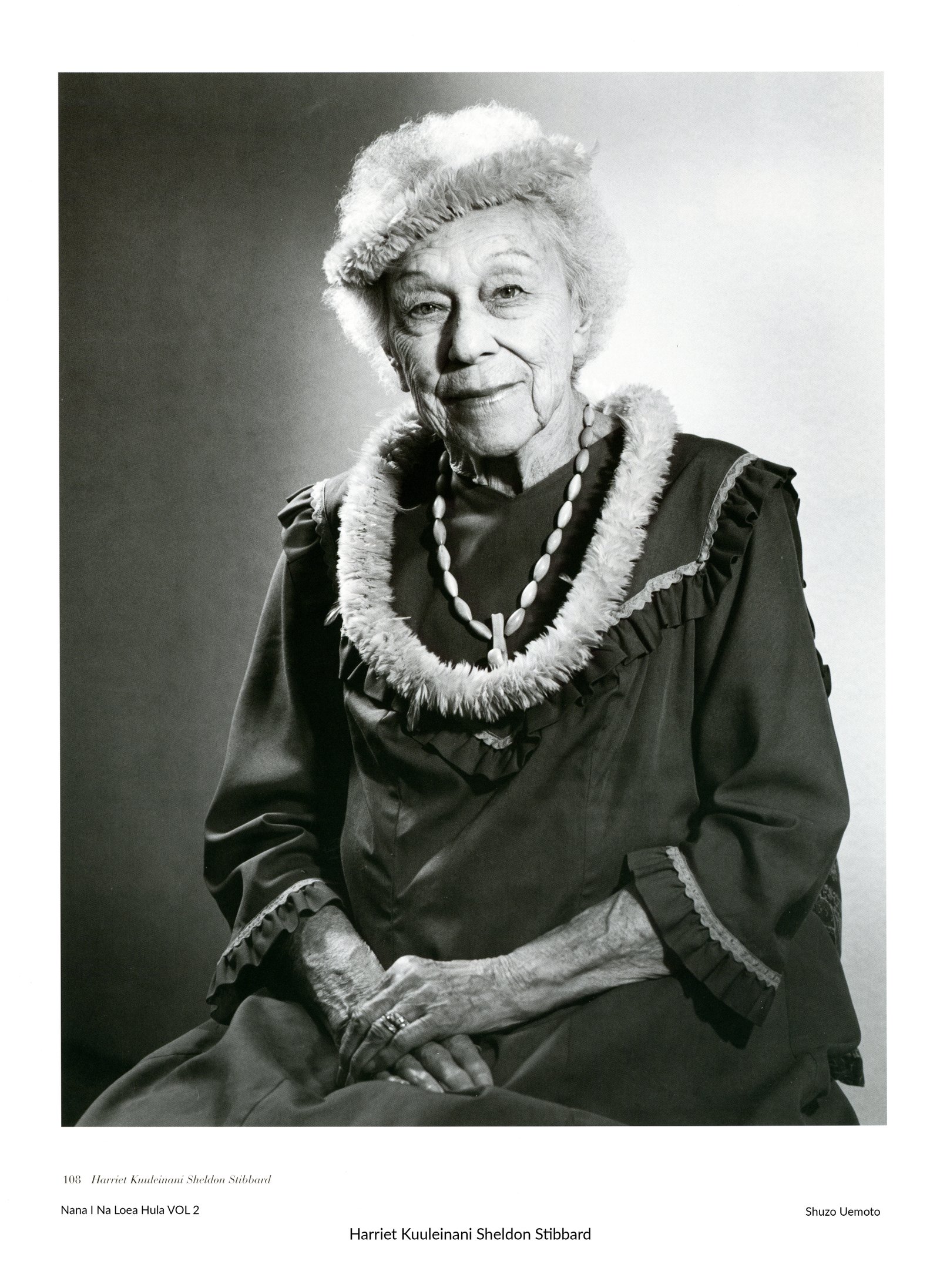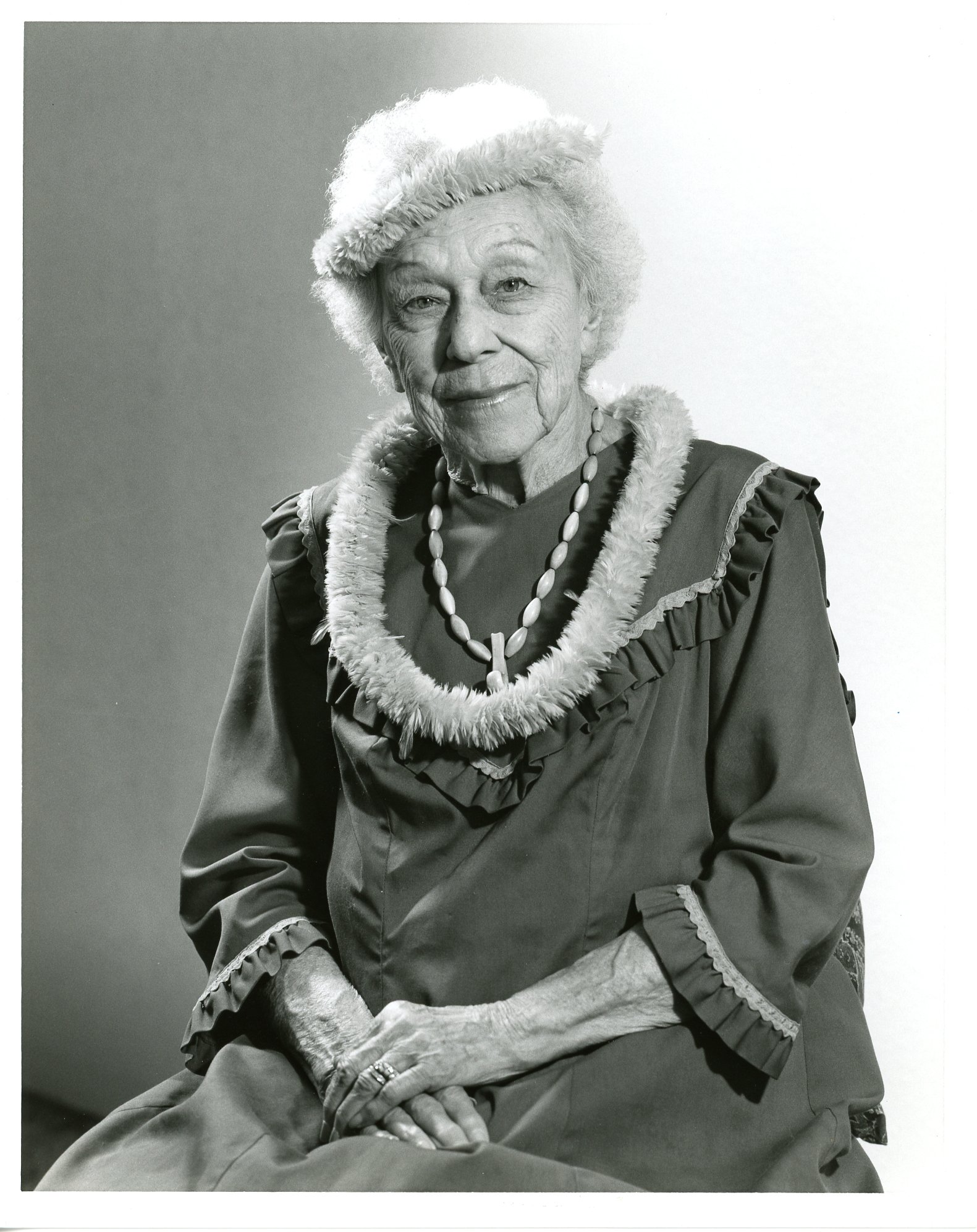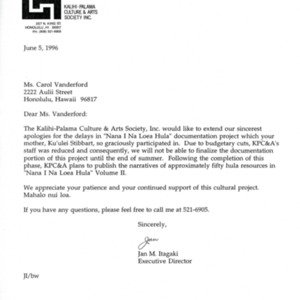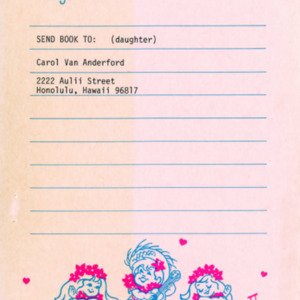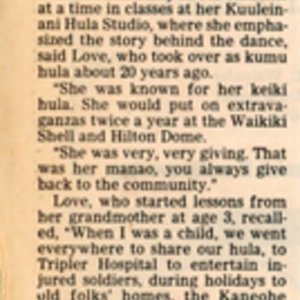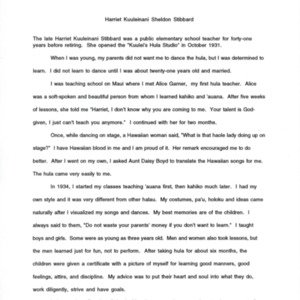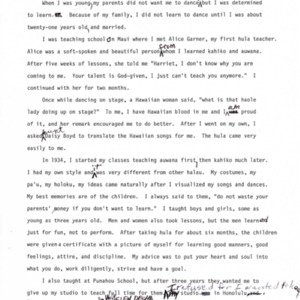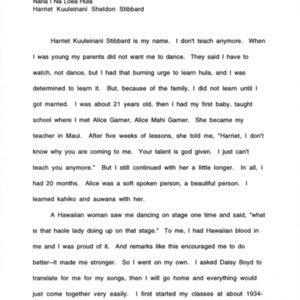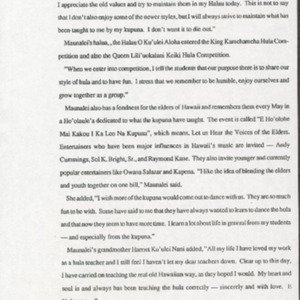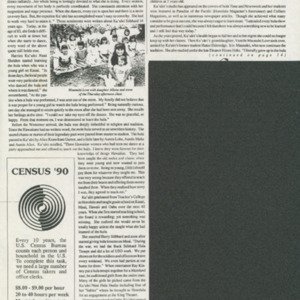Harriet Kuuleinani Sheldon Stibbard
Title
Harriet Kuuleinani Sheldon Stibbard
Subject
Nā Kumu Hula Harriet Kuuleinani Sheldon Stibbard - Nānā I Nā Loea Hula Volume 2 Page 109
Description
The late Harriet Kuuleinani Stibbard was a public elementary school teacher for forty-one years before retiring. She opened Kuulei’s Hula Studio in October 1931.
Once while dancing on stage, a Hawaiian woman said, “What is that haole lady doing up on stage?” I have Hawaiian blood in me and I am proud of it. Her remark encouraged me to do better.
When I was young, my parents did not want me to dance the hula but I was determined to learn. I did not learn to dance however until I was twenty-one-years-old and married. I was teaching school on Maui when I met Alice Garner, my first hula teacher. Alice was a soft-spoken and beautiful person from whom I learned kahiko and 'auana. After five weeks of lessons she told me, “Harriet, I don’t know why you are coming to me. Your talent is God-given. I just can’t teach you anymore.”
When I started my classes, I taught ‘auana first then kahiko much later. I had my own style and it was very different from other hālau. My costumes, pā‘ū, holokū, and ideas came naturally after I visualized my songs and dances.
After I went on my own. I asked Aunty Daisy Boyd to translate the Hawaiian songs for me. Language to me is very important in hula. If Aunty Daisy Boyd did not translate for me, I would not have been able to do anything.
My best memories are of the children. Some were as young as three-years-old. I always said to them, “Do not waste your parents’ money if you don’t want to learn.” After taking hula for about six months, the children were given a certificate with a picture of myself for learning good manners, good feelings, attire, and discipline. My advice was to put their heart and soul into what they do, work diligently, and set goals.
I also taught at Punahou School. After three years they wanted me to give up my studio to teach full time for them. I refused because I wanted to keep my studio in Honolulu. After one of my recitals in Hilo, Mrs. Helen Desha Beamer said that she would send her granddaughter to me for private lessons. That was a great honor to have Mama Beamer trust me.
I take pride in the fact that the students of Kuulei’s Hula Studio were on the cover of “Paradise of the Pacific,” “Time,” “Newsweek,” and inside of “Collier’s Magazine.” All of these articles and dates are in a book that my granddaughter Maunalei Love is using in her hālau O Kuʻulei Aloha. The newspaper articles about my keiki were tremendously rewarding.
The hula has changed a lot. When I look at the ‘uwehe of today, we never opened our legs. Old Hawaiians were rascal and naughty but in a clean way. I love kahiko but I never composed because I felt I was not an expert to do so. I prefer ‘auana songs especially “Mī Nei.”
I am very honored to be recognized today. It is a compliment when somebody reminds me that I was his or her teacher and that I was teaching their granddaughter. What a beautiful reward for me. My greatest joy is what I gave to the children because it lives on today.
Once while dancing on stage, a Hawaiian woman said, “What is that haole lady doing up on stage?” I have Hawaiian blood in me and I am proud of it. Her remark encouraged me to do better.
When I was young, my parents did not want me to dance the hula but I was determined to learn. I did not learn to dance however until I was twenty-one-years-old and married. I was teaching school on Maui when I met Alice Garner, my first hula teacher. Alice was a soft-spoken and beautiful person from whom I learned kahiko and 'auana. After five weeks of lessons she told me, “Harriet, I don’t know why you are coming to me. Your talent is God-given. I just can’t teach you anymore.”
When I started my classes, I taught ‘auana first then kahiko much later. I had my own style and it was very different from other hālau. My costumes, pā‘ū, holokū, and ideas came naturally after I visualized my songs and dances.
After I went on my own. I asked Aunty Daisy Boyd to translate the Hawaiian songs for me. Language to me is very important in hula. If Aunty Daisy Boyd did not translate for me, I would not have been able to do anything.
My best memories are of the children. Some were as young as three-years-old. I always said to them, “Do not waste your parents’ money if you don’t want to learn.” After taking hula for about six months, the children were given a certificate with a picture of myself for learning good manners, good feelings, attire, and discipline. My advice was to put their heart and soul into what they do, work diligently, and set goals.
I also taught at Punahou School. After three years they wanted me to give up my studio to teach full time for them. I refused because I wanted to keep my studio in Honolulu. After one of my recitals in Hilo, Mrs. Helen Desha Beamer said that she would send her granddaughter to me for private lessons. That was a great honor to have Mama Beamer trust me.
I take pride in the fact that the students of Kuulei’s Hula Studio were on the cover of “Paradise of the Pacific,” “Time,” “Newsweek,” and inside of “Collier’s Magazine.” All of these articles and dates are in a book that my granddaughter Maunalei Love is using in her hālau O Kuʻulei Aloha. The newspaper articles about my keiki were tremendously rewarding.
The hula has changed a lot. When I look at the ‘uwehe of today, we never opened our legs. Old Hawaiians were rascal and naughty but in a clean way. I love kahiko but I never composed because I felt I was not an expert to do so. I prefer ‘auana songs especially “Mī Nei.”
I am very honored to be recognized today. It is a compliment when somebody reminds me that I was his or her teacher and that I was teaching their granddaughter. What a beautiful reward for me. My greatest joy is what I gave to the children because it lives on today.
Citation
“Harriet Kuuleinani Sheldon Stibbard,” Nā Kumu Hula Archive, accessed November 28, 2025, https://nakumuhula.org/archive/items/show/152.
